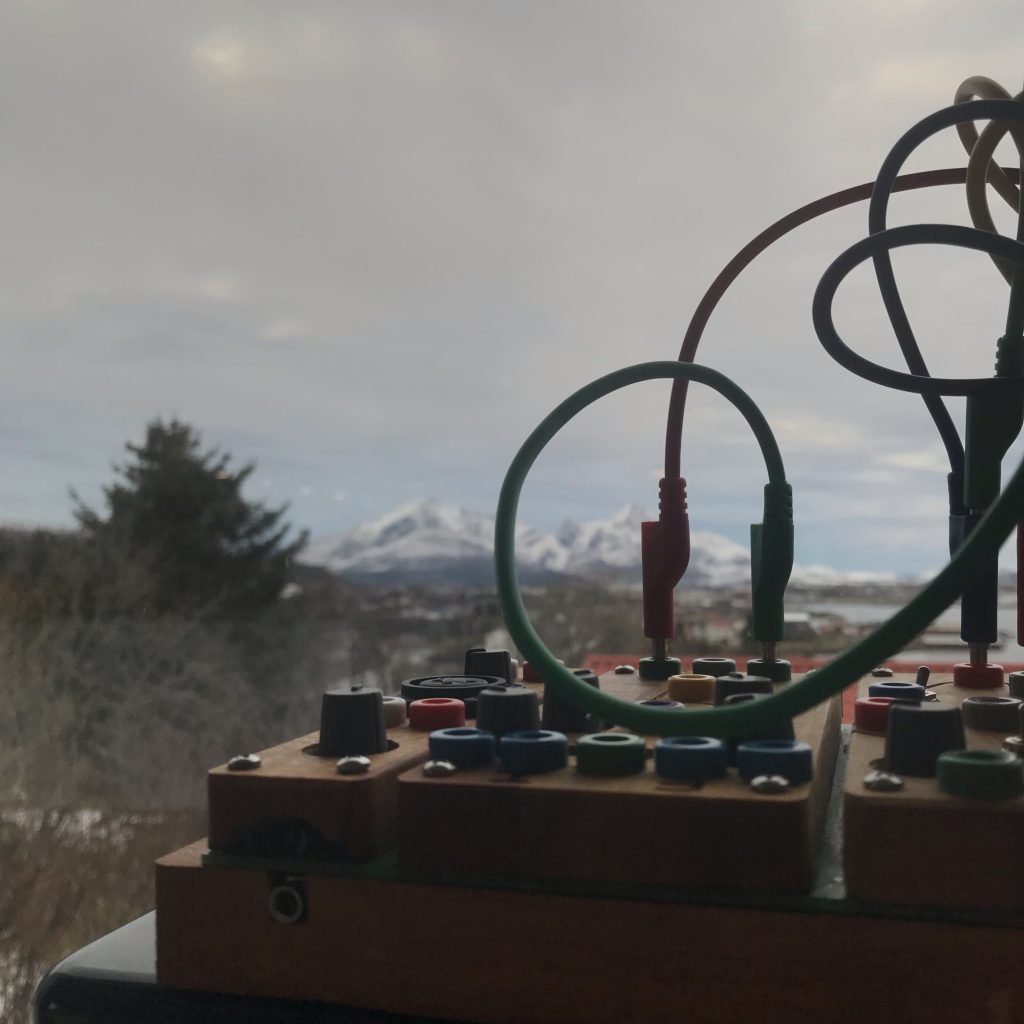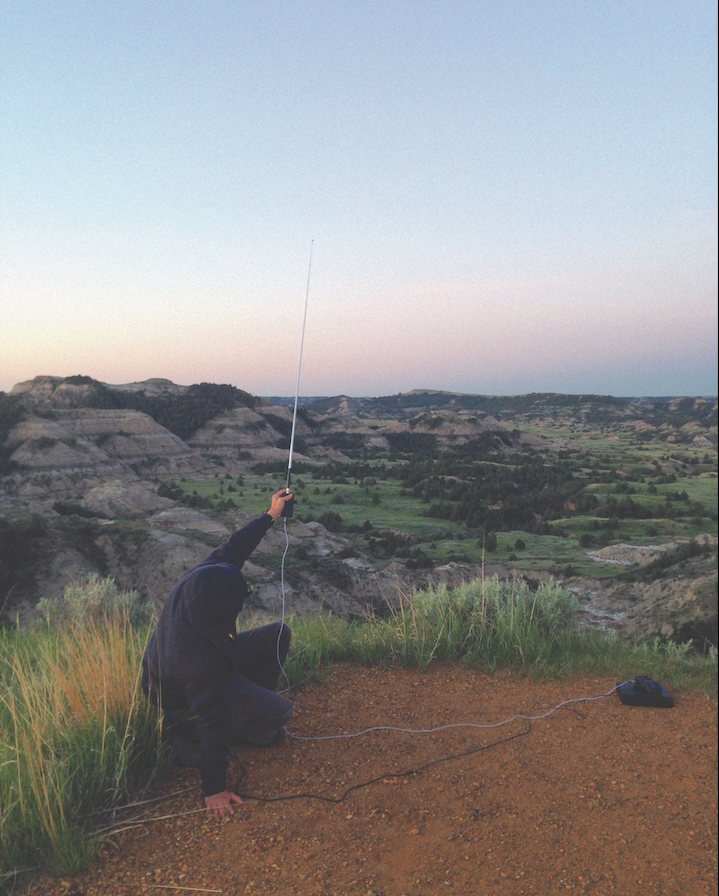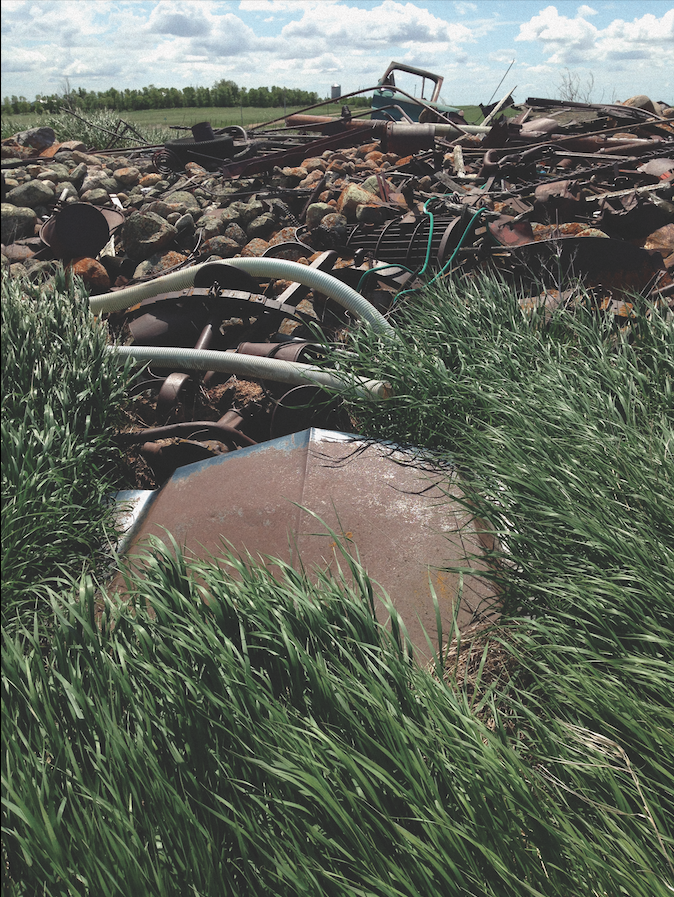Halloi! Here is a fresh from the oven interview with Are Mokkelbost, about the album Rundhåndet, which will be released on TIEP December 8th 2017.
1. What is a Tenori-On and what does it do?
It’s a small sequencer that Yamaha launched about ten years ago. It is handheld and based on an interface consisting of 16 x 16 luminous buttons that work both as a display and as an interface for making audio. It is powered by battery and has built-in speakers and sounds – like a small sketchpad for music really.
There are some similar things that are more advanced, but I immediately liked these limitations when I saw it in a store in Denmark. I did not buy it, but that night I dreamed a lot about it. So then I got the day after.

2. Where and how were the songs for Rundhåndet made?
I traveled a lot when I bought it, and in a time before smartphones I think it was magical to be able to make music at the airport or on the train. Later it was typically on the couch or the bed. A little like drawing doodles.
In the past, I had worked very linearly with audio, pasting and gluing directly into the timeline – so sequencing felt difficult. This became a gateway, and not being able to choose your own sounds was nice. It means that you can avoid thinking about genres, in a way.
Making many layers of simple shapes, which sum up to something else, that was more than enough for me. In addition, the Tenori-On has some fun, original angles on how to create arpeggios and sequences, such as bouncing balls and balls that fly between a note-constellation, which again can be rotated..!
Since this was pastime activity and playful exercises, expectations were none to zero – and so the music came pouring out. The songs have since have been on my hard drive until you guys asked if I had anything laying around.
3. What do you put in the term Rundhåndet?
It means to be generous, which fits since we are giving away this album for Christmas! And then it’s a very corny and literal picture of how the music is made; by pushing on and off round buttons with your hands…
4. How did you come up with the song titles? Why Norwegian titles? Could you imagine creating lyrics or libretto?
I think text and music is almost impossible to combine. I often perceive that vocals are a kind of shanghai’ing of music, a way to force the abstract into the literal language. But there are many exceptions to that, of course, but I don’t feel I can master anything like that.
The titles are inspired by the password generator of my internet banking. Each time you log in, it generates a random combination of an adjective and a noun, such as “Ivrig Bever” and “Snodig Elsker” – in Norwegian. It is like an intro course in poetry, and I find it always work on some level. You obviously understand the super-simple random algorithm while at the same time you can’t avoid imagining something. That is how it is with music and titles too; nothing is ever completely wrong, all combinations give a certain meaning. So then it is fun trying to hear the music for the first time and imagine what it IS, and forget how it came about.
5. What do you like best working with, music or art (if you were forced to choose)? Why? And what differences and similarities do you see in what you do as a visual artist and as a musician / composer?
I thought for a long time I had to choose, but gave it up. Today, I live off the visual arts strangely enough, so the music is automatically allocated to evenings and weekends. One of the great privileges of making art is to be able to listen to music at the studio all day. So I’m surrounded by music all the time, and since my music studio is in the same spot, everything is happening in close proximity.
At its best, one activity becomes time off from the other. Then you do not experience it as work anymore, but what can be called plus-energy activity. Or simply a great hobby. What serves this purpose depends on what you did during the daytime. If I have been sitting in front of my computer, I want to spend the evening away from the screen, so then it’s fitting to tweak physical sound boxes in the living room, do carpentry or something physical. Having worked at the workshop, it’s a luxury to sit down, open a sound project on my computer and edit last week’s improvisations – nice and clean.
This is one similarity between how I work with art and music: I like to change between periods of improvisation and editing – I rarely produce anything in one go. I guess most people work like this, it just seems I tend to repeat the process quite a few times. It is like I have to leave the material for a great while to be able to hear it freed from my original intentions. And then cut it into pieces and then try to repair it again, having changed it completely in the process.
Another hang up that I have had over the last couple of years is to use concepts and formalistic ideas more as starting points, often leaving them behind as the work comes into its own. If there was any relevance to the idea then it hopefully is present somehow, if not at least it gives the process a specific direction I can respond to. Simply stated I am more interested in concepts as temporary fixtures, not an aim in itself. An ideal to strive towards, at least.
6. Does it matter to you whether tools / materials are digital or analogue? What do you think of the new Eurorack enthusiasts? And how is the Tenori as a (relatively limited) digital box interesting, compared to advanced controllers for Ableton Live and alike?
With images and music, I increasingly like to base myself on very simple formal premises, and see how far I can get. I have previously worked with more complex systems with many rules at the same time, while now I try to reduce to fewer parameters at a time.
Often the formal premise lies in the technology itself, whether it is scissors and paper, stained glass, drum machines or image scanners. The simpler the starting point is, the easier it is to begin the process of getting to know a new technique, I find. Then you always go deeper later, as a consequence of having spent time with it.
So I really like both: I need tools that are high end and deep (usually more expensive) and more eclectic stuff that only does one thing (usually cheaper), where the fun lies in luring something interesting out of them. Be it digital or analogue. I’m just as fond of my small, roll out pocket organ with low-resolution sounds, as of my expensive, digital FM synthesizer.
Another example: I’ve created a large audio library based on the recording of feedback loops I’ve made with various low cost effect units. The feedback chains in effect become a form of synthesis that generates lots of strange sounds that I isolate and use when making other music. At this point it’s great to be able to use Ableton Live’s samplers and juicy plugins to wedge it well into the rest of the music.
I haven’t dared starting with Eurorack yet, because I’m still battling with what feels like endless possibilities in the rig I already have. And because of the limited space in my studio. After a period of knob tweaking in real-time, I’m also ready to go back into the editing process again, being more interested in having the music occur in the cutting and pasting itself, and less as a steady stream of sound from various sources. But if I find some productive limitations I can cultivate in the Eurorack format, I´m sure I will end up there too.
7. What do you think about the relationship between recorded music and live music? Are improvisation, coincidence and generative processes important to you, or do you want to compose / write music in a more classic sense?
Live music is a kind of fresh goods, a way to be together at a given moment, like a mix of a concentration exercise and collective daydreaming, gone when it´s over. And I love it for those qualities. And then I love composed music, as carefully organized sounds assembled by one human being, made for other people’s private experience, potentially to be enjoyed at various times in the endless future.
I have to say that over the years I have been going less and less to shows. There are so many things that I am wary of at concerts at this point, which tend to take over the whole experience, for a cranky, old man like myself. But in the right setting it’s amazing, of course. More daytime hours and food in combination with music, please!
I improvise just about every day – on the organ in the studio, on various gadgets I’m taking home from the studio, and so on. However, recordings as documentation of live music I rarely listen to. I remember, I had a heated discussion with Keith Rowe about this many years ago at the art academy – he thought it was something bourgeois and speculative with composed music, that free improvisation was more real and direct. He elevated that moment when the music occurs in real time, and put it in opposition to the organized sound. When I asked what he was thinking about when he was improvising music, he answered the “the struggle of the working class”. Wow! To me, there is nothing more generous and touching than carefully organized music that can be experienced by anyone regardless of time and space.
To me, improvisation is a prerequisite for composition. Just as when cutting in pictures, I like to manage sonic building blocks of information that has a defined energy and then see how they affect each other. These are completely unpredictable things that can hardly be hatched out in advance. The few times that I compose things from scratch from an idea, almost without exception it turns out totally different than I expected. Then the dilemma arises between harrowing on with the original intention, or trying to work more pragmatically from what have arisen and do something else. Any which way I have to cut and paste in the material until it starts to resemble something that I want to listen to again – which is the only relevant goal. I envy those who work in a linear way, but I can´t seem to do it like that.
As such, this album is untypical – it is more like a selection of more spontaneous sketches that I think have just enough to them to be spared a lifetime sentence on a hard drive.
8. Do you play concerts with the Rundhåndet material? If so where and how?
Sure, I will play some if asked! Like for example now when the album is to be released at Rett Ned (a concert series). Weirdly enough, last time I played with the Tenori-On was for the Norwegian King. I doubt that it will be stranger than that!
9. Do you have any other synths, sequencers, software etc. you like to work with?
Two favorites are the Tempest drum machine by Dave Smith Instruments and the Nord Lead 3 digital synthesizer by Clavia. They are both instruments where you can go deep and design your own sounds, and I use that a lot. They can make everything from very clean and pretty sounds to really mean sounding things. There are so many corny presets out there, so I find it a big challenge to make a palette of sounds that seem natural and simple enough, somehow.
I also have many of Elektron’s machines and love the parameter lock feature there. But it annoys me that they always have to vary where the buttons are located and that they do not have individual ADSR envelopes on all sounds, more LFOs and deeper synth engines.
10. Do you have any new music on time?
Thank you for asking! I have done lots of sketches over the last ten years on a lot of different gear, in a period where I have had to prioritize working on art commissions during the daytime. Now I finally have the time and studio space to work with music again and am seeing the contours of some albums. We’ll see!

More about Are: www.aremokkelbost.com






















